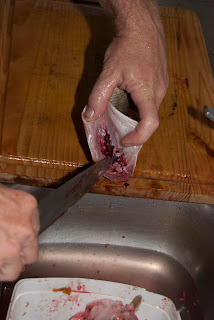Whole fish with head on / head off, scaled whole, fillets....
I thought I would share my technique for a quick & clean fish cleaning.
Start with plenty of bench space on / near the sink, a nice sharp knife & a container handy for the innards & heads.
Give the fish a quick wash down as this removes most of the body slime and makes it a little easier to handle safely.
Start you first cut from the vent and slice up the belly to the chest, cut from vet to rear of belly also.
Place tip of knife near the lower edge of the gills & above pelvic fins. Pierce down through the whole body and cut cleanly behind the pelvic fin.
Flip the fish over and place tip of knife behind the gill covers & above the pectoral fin. Cut down through the back bone to the top of the head.
At this stage wedge your fingers into this cut to slightly separate the head.
Hold fish over your waste container and finish the cut to sever the head from the body, most of the innards will simply fall out attached to the head.
Use your knife to scrape away remaining loose innards.
Inside the body cavity you will see the swim bladder attached along the backbone.
Gently cut & scrape along the backbone to help loosen the swim bladder lining away.
Pull away remaining lining and repeat as needed to remove the final bits.
As silver perch have very small scales I did not bother to scale the fish. If you wish to scale your fish, that would probably be best done as step 1.


















